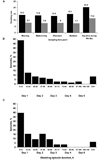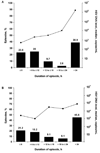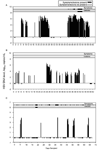Rapidly cleared episodes of herpes simplex virus reactivation in immunocompetent adults
- PMID: 18783315
- PMCID: PMC2667115
- DOI: 10.1086/591913
Rapidly cleared episodes of herpes simplex virus reactivation in immunocompetent adults
Abstract
Background: Herpes simplex virus (HSV) remains latent in nerve root ganglia of infected persons and is thought to reactivate several times yearly. Recent in situ data show the localization of HSV-specific CD8(+) T cells at the dermal epidermal junction next to peripheral sensory nerve endings, suggesting that viral reactivation may occur more frequently than previously appreciated.
Methods: Twenty-five HSV-2-seropositive and 18 HSV-1-seropositive healthy adults collected anogenital and oral swabs, respectively, 4 times per day for 60 days. Swabs were assayed for HSV, using a quantitative polymerase chain reaction assay.
Results: Twenty-four percent of anogenital reactivations and 21% of oral reactivations lasted < or =6 h, and 49% of anogenital reactivations and 39% of oral reactivations lasted < or =12 h. Lesions were reported in only 3 (7%) of 44 anogenital reactivations and 1 (8%) of 13 oral reactivations lasting < or =12 h. The median HSV DNA levels at initial and last detection were 10(3.5) and 10(3.3) copies/mL, respectively, during anogenital reactivation and 10(3.7) and 10(3.0) copies/mL, respectively, during oral reactivation.
Conclusions: This high frequency of short subclinical HSV reactivation in immunocompetent hosts strongly suggests that the peripheral mucosal immune system plays a critical role in clearing HSV reactivations.
Conflict of interest statement
Potential conflicts of interest: A.W. has received grant support from GSK, Antigenics, 3M, Roche, and Vical; has been a consultant for Novartis, Powdermed, and Medigene; and has been a speaker for Merck Vaccines. L.C. has done consulting for Antigenics. All other authors: no conflicts.
Figures



Comment in
-
Asymptomatic shedding of herpes simplex virus 1 and 2: implications for prevention of transmission.J Infect Dis. 2008 Oct 15;198(8):1098-100. doi: 10.1086/591914. J Infect Dis. 2008. PMID: 18783317 No abstract available.
References
-
- Xu F, Sternberg MR, Kottiri BJ, et al. Trends in herpes simplex virus type 1 and type 2 seroprevalence in the United States. JAMA. 2006;296:964–973. - PubMed
-
- Croen KD, Ostrove JM, Dragovic L, Straus SE. Characterization of herpes simplex virus type 2 latency-associated transcription in human sacral ganglia and in cell culture. J Infect Dis. 1991;163:23–28. - PubMed
-
- Wald A, Zeh J, Selke S, Ashley RL, Corey L. Virologic characteristics of subclinical and symptomatic genital herpes infections. N Engl J Med. 1995;333:770–775. - PubMed
-
- Mertz GJ, Benedetti J, Ashley R, Selke SA, Corey L. Risk factors for the sexual transmission of genital herpes. Ann Intern Med. 1992;116:197–202. - PubMed
-
- Brown ZA, Wald A, Morrow RA, Selke S, Zeh J, Corey L. Effect of serologic status and cesarean delivery on transmission rates of herpes simplex virus from mother to infant. JAMA. 2003;289:203–209. - PubMed
Publication types
MeSH terms
Substances
Grants and funding
LinkOut - more resources
Full Text Sources
Other Literature Sources
Medical
Research Materials

